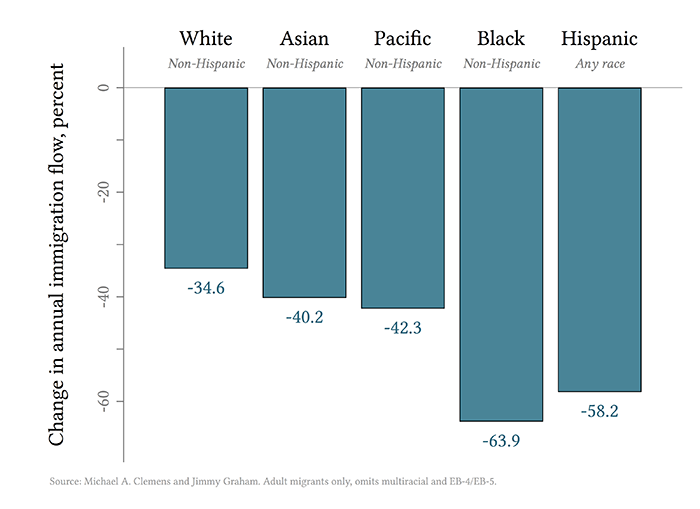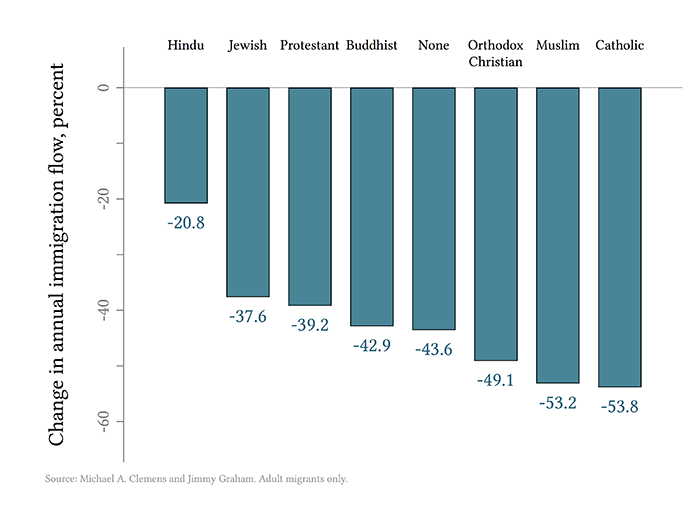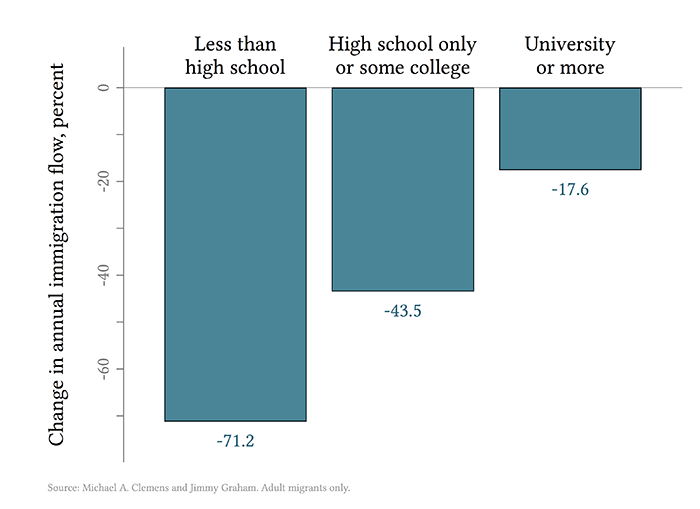As the US Administration presses for the most extensive revision to immigration law since 1965, with the largest cuts to legal immigration since 1924 in the proposed “Securing America’s Future Act,” a new CGD analysis quantifies for the first time how the proposed cuts would affect the ethnic, religious, and educational composition of immigration flows.
We find:
- Hispanic and black immigrants would be roughly twice as likely to be barred by the immigration cuts as white immigrants;
- The cuts would bar the majority of Muslim and Catholic immigrants; and
- The cuts would substantially reduce the number of university-graduate immigrants. Expanded work visas would only add one university graduate for every seven low-skill workers removed by eliminating family visas and Diversity Visas.
Below, we provide a tool that anyone can use to approximate the ethnic effects of a US immigration reform proposal.
Ethnic impacts
Here we provide the first quantitative estimates of how the latest specific immigration reform proposal would alter the ethnic composition of US immigration flows. We analyze the “Securing America’s Future Act” (H.R. 4760) introduced in Congress earlier this month and closely corresponding to the Administration’s immigration policy priorities. We estimate that this Act would cause the following changes in the ethnic composition of new immigration inflows:

That is, in the annual flow of immigrants after such a reform relative to before the reform, the number of non-Hispanic whites would fall by about 34.6 percent. The number of non-Hispanic blacks would fall by 63.9 percent, and the number of Hispanics of any race would fall by 58.2 percent. In other words, comparing the immigration flow with the reform to without it, the chance that any given black or Hispanic immigrant would be barred by the reform is about twice the chance for a white immigrant. This is straightforward consequence of the high representation of these groups in visa categories that would be reduced or eliminated by the reform: family reunification visas for Hispanic immigrants, and Diversity Visas or refugee visas for black immigrants, particularly black African immigrants.
How we found these results: We start with the immigration flows under each visa class in the proposed visa quotas in the Act and the actual immigration flows of each type in the most recent year for which statistics are available (2016). We then estimate the ethnic composition of visa’s recipients via the only available estimates of the ethnic composition of new immigrants in each visa category. These come from a unique survey of a representative sample of all US immigrants in a typical recent year: the 2003 cohort of new US immigrants—reported by Guillermina Jasso and supplemented by our own analysis of the underlying data from the New Immigrant Survey. (No other cohort has been surveyed in this fashion.) We omit relatively small numbers of people who report more than one race, we omit people who report their race as American Indian, and we omit a handful of very small visa categories (EB-4/5). The results are estimates rather than exact forecasts because they rely on the ethnic composition of one past cohort of immigrants.
Along with the above results, we offer a tool that anyone can use to understand and adjust these estimates for themselves. The spreadsheet calculations for all the figures in this post are available here. The spreadsheet can be used as a tool to estimate the ethnic effects of any immigration reform proposal, simply by filling in the revised visa quotas in that proposal. We also post it to show the assumptions and data sources underlying the figures. The Stata code to produce some of the ethnic shares in that spreadsheet, using the raw New Immigrant Survey data, is here.
Religious impacts
We use the same method to assess the impact of the Administration’s reform proposals on the ethnic composition of immigration:

That is, in the annual flow of immigrants after such a reform relative to before the reform, the number of Muslims would fall by about 53.2 percent and the number of Catholics would fall by about 53.8 percent. In other words, the reform would eliminate most Muslims and Catholics from the flow of new US immigrants. This is a straightforward consequence of the fact that these groups are disproportionately represented by the recipients of visas that would be reduced or eliminated by the reform: Muslims among Diversity Visas and refugee visas, and Catholics among family-reunification visas.
Education impacts
The Administration has stated that the US economy needs more skilled immigration. We can analyze in the same way the effect of the reform proposals on educational attainment among US immigrants:

That is, in the annual flow of immigrants after such a reform relative to before the reform, the number of immigrants with a university degree or advanced degree would fall by about 17.6 percent. The decline for other educational groups would be larger. The proposal to eliminate several categories of family-reunification visas would remove about 267,000 workers with less than high school from the annual immigration inflow, while the proposal to expand employment-based visas for high-skill workers would add about 38,000 workers with university or more to the annual immigration inflow. In other words, expanded work visas would only add one university graduate for every seven low-skill workers who are removed by eliminating family visas and Diversity Visas. The proposal would therefore do little to shift immigration toward higher skill, but much to reduce immigration in general.
The fall in the number of university-educated immigrants is a consequence of the fact that, while the Administration proposes to raise quotas for employment-based visas requiring university education, it also cuts other categories of visas that include large numbers of university graduates. For example, about 41 percent of immigrants in the New Immigrant Survey who acquired permanent residency through the Diversity Visa have a university degree or more, and the reforms seek to eliminate this visa.
These estimates are preliminary and approximate because they rest on assumptions. We consider the assumptions reasonable for this purpose, but they are certainly debatable. Further analysis could and should improve on them. One is that the baseline immigration rate in each visa category is the actual immigration rate for Fiscal Year 2016. That assumption would be less reasonable as the analysis extends further into the future. A second assumption is that the composition of immigrants from the cohort studied by the New Immigrant Survey would be similar for cohorts in the near future. We consider this reasonable for race and religion; for education it is clear that education levels among the slashed visa categories is higher today than for the immigrants in the New Immigrant Survey—as shown by David Bier—which implies that the decrease in skill among immigrants would be even larger than that estimated above. A third assumption is that minor children in the F2A and F4 visa categories have the same distribution of characteristics as adults who receive those visas. (The New Immigrant Survey does not report race or religion for a representative sample of minor children receiving these visas, and obviously cannot report educational attainment for minor children.)
We find it reasonable to assume that the racial and religious composition of minor children sponsored for those visas is similar to the composition for adult children and other adults sponsored for those visas, but we cannot test the accuracy of that assumption. For the education outcome this assumption would tend to create a small bias, because the eventual educational attainment of people who immigrate as young children will almost certainly be higher than the educational attainment of adults who immigrate on that visa—in visa categories where adult education is very low. But such a bias is immaterial to the conclusions of the analysis because it would mean that the effect of the immigration reform on typical educational attainment in the immigrant flow would be even less positive than described above. For example, in the F2A visa category in Fiscal Year 2016 there are 62,644 minor children, and in the F4 category 27,073 minor children. The average educational attainment of adults in the F2A category is 8 years. The above analysis treats the removal of the children from the F2A inflow as if the minor children, too, would have 8 years of education, and removing such low-education immigrants from the inflow would substantially raise average education among immigrants. But if their eventual educational attainment would be higher than 8 years on average in the United States, which is all but certain, removing them from the immigrant inflow would raise average education among immigrants by less than shown above. In short, the conclusions of the analysis are unlikely to be substantially sensitive to these assumptions.
We encourage policymakers, journalists, and all those interested in estimating the effects of other immigration reform proposals in the future to use the tool we’ve created.
This post was updated on February 6 to include a detailed discussion of the assumptions underlying the analysis, in response to reader questions (thank you!), and correct errors in the text describing the population scope and education impact.
Disclaimer
CGD blog posts reflect the views of the authors, drawing on prior research and experience in their areas of expertise. CGD is a nonpartisan, independent organization and does not take institutional positions.





